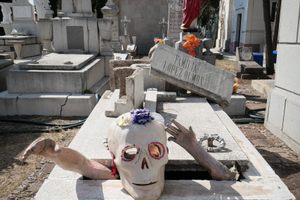About
In the heart of the Spanish Colonial city of Aguascalientes lies a surprisingly massive new art museum and cultural hub. A prime example of ‘adaptive reuse’, the museum is an architectural experience – even before witnessing the art.
Formerly the site of an old railway workshop, remnants of the original tracks can be seen throughout the museum’s glass-paneled floors and echoed again in the vast steel, brick, and concrete interiors. But rather than feel sterile or uninviting, the exhibition spaces feel awe-inspiring and intimate, despite the colossal space.
“The architecture responds, in the first instance, to the spatial needs of the railroad workshops,” says Yolanda Hernández, coordinator of Museo Espacio. The original site dictated the museum’s obvious architectural form, but the museum also took design cues from other new cultural sites like the Centro Nacional de Arte y Cultura Georges Pompidou. The delicate play of light and shadow, coupled with the interior dimensions and large-scale works, lend a sense of infinite possibility within the walls, allowing the artworks to truly breathe.
Inaugurated in 2016, Museo Espacio brings in visitors with exhibitions from seminal artists such as Javier Marín and Jannis Kounellis. In only a few years, Museo Espacio broke attendance records and became the most visited museum in all of Aguascalientes. This was, in large part, due to a recent exhibition by Michoacan artist Javier Marín, whose work has been displayed at international galleries such as the Royal Museums of Fine Arts of Belgium and the Place du Louvre in Paris, among others.
Marín’s exhibition entitled “Claroscuro” includes a set of towering male-female sculptures carved from sacred Sequoia trees. Most museums wouldn’t normally be able to fit such an ambitious large-scale work inside four walls, but Museo Espacio’s massive open space allowed the sculptures to stand erect in one of the main galleries. The imposing walls also allowed for the artwork to develop in unusual ways and take on new dimensions.
The exhibition also includes haunting sculptural heads and distorted faces of beheaded men and fallen angels writhing in agony, resembling something out of Dante’s Inferno. A sense of movement is apparent in the twisted forms; and the museum’s stark interiors seems to unleash the artwork’s purgatorial atmosphere, balancing the tension between tranquility and torture, peace and unease.
“Through this monographic exhibition, the viewer was able to take a tour through more than 30 years of [Javier Marín’s] artistic experience, ranging from graphics, through painting to sculpture,” says Hernandez. “The scrutiny of the materials, the techniques and the aesthetic possibilities [present in] each of the more than 70 pieces that were exhibited in the halls, [shows] a clear contrast between life and death, light and dark.”
Concerned with the effects of war, traces of the artist’s political outrage and obsession with capturing the human condition permeate each work. “Javier Marín takes human nature as its main mold and prints collaborative features and imperfections, transforming them into aesthetic beauty. Each of these features was more than evident, thanks in large part to the complicity of the architectural space of the site,” Hernandez continues.
Housing such monumental, genre-shattering artworks feels appropriate inside such a historically rich site. “In particular for the natives of the State, the museum represents a symbol of melancholy and union,” says Hernandez, “since all the families here had a relative or someone very close working in the railway workshops during its apogee, so this space is well appreciated and valued.”
Know Before You Go
Museo Espacio is open from 11 AM until 8 PM everyday except Tuesday.
NEW - Yucatan: Astronomy, Pyramids & Mayan Legends
Mayan legends, ancient craters, lost cities, and stunning constellations.
Book NowCommunity Contributors
Added By
Published
March 28, 2019






































